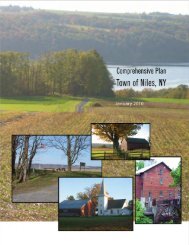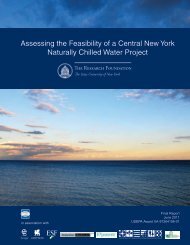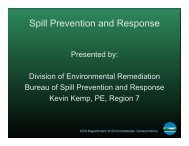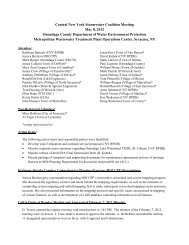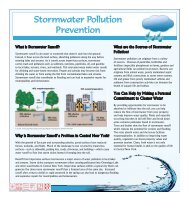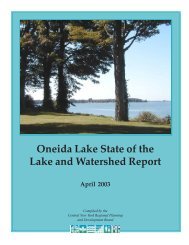A Management Strategy for Oneida Lake and its ... - CNY RPDB Home
A Management Strategy for Oneida Lake and its ... - CNY RPDB Home
A Management Strategy for Oneida Lake and its ... - CNY RPDB Home
You also want an ePaper? Increase the reach of your titles
YUMPU automatically turns print PDFs into web optimized ePapers that Google loves.
Presentation Summaries<br />
CONTROL STRUCTURES THAT<br />
INFLUENCE ONEIDA LAKE LEVELS<br />
By Howard Goebel - NYS Canal Corporation,<br />
Albany, NY<br />
Control Structures<br />
- Caughdenoy Dam (7 taintor gates that span<br />
the <strong>Oneida</strong> River <strong>and</strong> 1 slide gate that is part<br />
of the old Oswego Steamboat Canal) along the<br />
<strong>Oneida</strong> River, the <strong>Oneida</strong> <strong>Lake</strong> outlet.<br />
- Lock E-23 at Anthony’s Cut, (navigation<br />
lock only, no flow releases at any time).<br />
- Lock E-24 in Baldwinsville along the Seneca<br />
River, one taintor gate, 350-foot long concrete<br />
overflow spillway, <strong>and</strong> 2 hydropower generation<br />
facilities.<br />
- Lock O-1 in Phoenix along the Oswego<br />
River, 6 taintor gates, 540-foot long concrete<br />
overflow spillway, <strong>and</strong> 1 hydropower generation<br />
facility.<br />
- Lock O-2 in Fulton along the Oswego River,<br />
6 taintor gates, 200-foot long concrete overflow<br />
spillway, <strong>and</strong> 2 hydropower generation<br />
facilities.<br />
Primary Control Structures<br />
The Caughdenoy Dam is the primary control<br />
structure during the Navigation Season (May<br />
through October). During non-navigation<br />
season (November through April), all gates of<br />
the Caughdenoy Dam are completely open.<br />
The observed lake levels are a function of the<br />
natural precipitation <strong>and</strong> runoff cycle, including<br />
snowmelt coupled with the hydraulic<br />
capacity of the <strong>Oneida</strong> River with the<br />
Caughdenoy Dam fully opened.<br />
Secondary Control Structures<br />
The hydraulic capacity of the <strong>Oneida</strong> River<br />
during the non-navigation season may be<br />
partially affected by any or all:<br />
- The natural Caughdenoy Shoals along the<br />
<strong>Oneida</strong> River.<br />
- The remnants of the original Caughdenoy<br />
Dam that was taken out of service in 1952.<br />
- The NYS-DOT bridge (Route 33) immediately<br />
downstream of the existing Caughdenoy<br />
Dam. Considerable sediment is present on the<br />
upstream side of this bridge that reduces the<br />
hydraulic capacity of the river.<br />
- Flows from the Seneca River at the Three<br />
Rivers junction (impacted by controls at Lock<br />
E-24 in Baldwinsville).<br />
- Operation of the hydropower generation<br />
facility at Lock O-1 in Phoenix owned by<br />
Oswego Hydro Partners in concert with<br />
operation of 6 taintor gates owned by the New<br />
York State Canal Corporation (NYSCC) that<br />
are part the dam that creates the navigation<br />
pool above Lock O-1. Oswego Hydro Partners<br />
operates <strong>and</strong> maintains the 6 taintor gates<br />
in accordance with operation <strong>and</strong> maintenance<br />
agreement with the NYSCC that is part of<br />
their Federal Energy Regulatory Commission<br />
(FERC) license.<br />
- Operation of two hydropower generation<br />
facilities at Lock O-2 in Fulton owned by<br />
Reliant Energy in concert with operation of 6<br />
taintor gates owned by the New York State<br />
Canal Corporation that are part the dam that<br />
that creates the navigation pool above Lock O-<br />
2. Reliant Energy operates <strong>and</strong> maintains the<br />
6 taintor gates in accordance with operation<br />
<strong>and</strong> maintenance agreement with the NYSCC<br />
that is part of their Federal Energy Regulatory<br />
Commission (FERC) license.<br />
<strong>Oneida</strong> <strong>Lake</strong> Level Control Issues<br />
The NYSCC is required to provide minimum<br />
water levels <strong>for</strong> navigation purposes <strong>and</strong> is<br />
responsible <strong>for</strong> the conditions of the canal<br />
page 94<br />
Appendices



